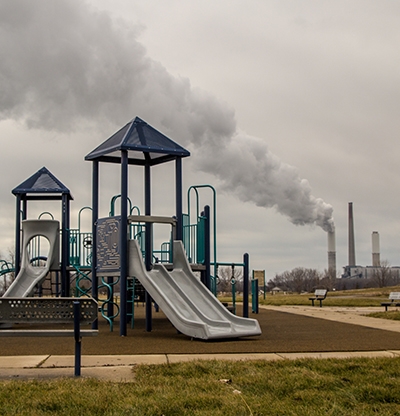>> Go to Air Toxics at School interactive tool
Press Release
The Corporate Toxics Information Project (CTIP) of the Political Economy Research Institute (PERI) at the University of Massachusetts Amherst published an update of Air Toxics at School, an interactive web-based tool for tracking industrial toxic air pollution at every public and private school in the U.S. Air Toxics at School reports toxicity-weighted concentrations of pollutants to show individual chronic human health risk from industrial toxic air pollutants at the school location. PERI's Air Toxics at School shows the comparative individual chronic health risk from industrial toxic air pollution at each K-12 and higher-education institution in the United States, identified in databases maintained by the U.S. Department of Education. Each school was matched to 2020 U.S. EPA pollution data to show toxic air pollution at the school site. The air pollution analyzed comes from large fixed sources, such as factories, refineries, petroleum depots, metal mining, and toxic disposal facilities.
Users can look up any school in the United States and receive a report on the industrial facilities and the toxic chemicals that generate health risks at the school location. The report on each school lists pollution sources affecting the school and puts the impact in comparative context relative to all schools in the state and in the country. Users can also receive a report on all schools in a state. For example, the average air pollution at schools in Illinois is about 22% more than the national average, with nickel, manganese, and chromium among the leading pollutants. The five schools in Illinois with the highest air pollution, in the Illinois cities or towns of Loves Park, Machesney Park, and East Alton have air pollution in the top percentile in both the state and the US.
The U.S. EPA Toxics Release Inventory (TRI) reports annual releases of approximately 600 toxic chemicals by some 20,000 major industrial facilities in the United States (and does not include pollution from mobile sources, agriculture, fracking, or other sources that are also major contributors to health risk from air pollution). U.S. EPA uses geographic, facility, and chemical data to estimate the concentrations of pollutants in every 810 m by 810 m square within 50 km around every facility. These estimates are the basis of the Air Toxics at School reporting. EPA models toxicity to capture chemical danger on a per-pound basis.
The interactive tool allows users to search schools by name or location and to explore results in more detail. Facility names are linked to EPA's Envirofacts Toxic Release Inventory display for that facility. Parent company names are linked to PERI's 2020 Toxic 100 Air application, which shows a detailed display of all the TRI-reporting facilities owned by the company, all TRI chemicals released, and environmental justice indicators for toxic air pollution from the company's facilities. Chemical names are linked to New Jersey Right-To-Know Hazardous Substance Fact Sheets on chemical health effects. City names are linked to a Mapquest street map centered on the school's latitude/longitude. Air Toxics at School is modeled on the web- based tool provided by the award-winning 2008 USA Today project “The Smokestack Effect: Toxic Air and America’s Schools.”
The goal is to facilitate public access to public information and to engender discussion among parents and students, staff and teachers, school administration, regulators, companies, and the broader public. “This tool builds on the achievements of the right-to-know movement,” notes CTIP co-director Professor Michael Ash, “Our goal is to engender public participation in environmental decision-making, and to help residents translate the right to know into an equitable right to clean air, clean water, and a livable planet. We hope that the public uses this tool to inform and empower itself.



